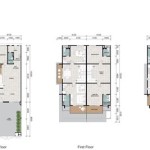Understanding the Essence of the Venturi House Floor Plan
The Venturi House, designed by revered architects Robert Venturi and Denise Scott Brown, has become a cornerstone of postmodern architecture. Its revolutionary floor plan broke away from traditional design principles, introducing a new language of architectural expression.
The Venturi House floor plan is characterized by several essential aspects:
Asymmetry and Complexity: Unlike traditional symmetrical designs, the Venturi House plan embraces asymmetry and irregularity. Rooms are arranged in a seemingly haphazard manner, creating a sense of surprise and intrigue.
Ambiguity and Flexibility: The plan deliberately lacks clearly defined spaces. Rooms can serve multiple functions, empowering homeowners with the flexibility to adapt the space to their changing needs.
Contrasting Spaces: The floor plan juxtaposes contrasting spaces, creating an interplay of scale and proportion. Grand, open areas are balanced by intimate and cozy nooks, enhancing the overall spatial experience.
Clear Axial Circulation: Despite its complexity, the Venturi House plan incorporates a clear axial circulation system. This central spine allows for effortless movement throughout the house, connecting different areas.
Hierarchies of Space: The plan establishes a hierarchy of spaces, with public and private areas clearly distinguished. The public areas, such as the living room and kitchen, are designed to foster social interaction, while the private areas, such as the bedrooms, provide sanctuary.
Symbolic and Metaphoric Elements: Venturi incorporated symbolic and metaphoric elements into the floor plan. The curved roofline resembles a duck's bill, while the triangular windows evoke the vernacular architecture of the surrounding neighborhood.
Integration with the Landscape: The Venturi House seamlessly blends with its surrounding landscape. The floor plan extends the interior spaces into the outdoor terraces and gardens, creating a harmonious relationship between architecture and nature.
In conclusion, the Venturi House floor plan is a groundbreaking architectural achievement that challenged conventional design principles. Its asymmetry, flexibility, contrasting spaces, and symbolic elements have influenced generations of architects, solidifying its place as a cornerstone of postmodern architecture.

Ad Classics Vanna Venturi House Robert Archdaily

File Vanna Venturi Ground Floor Plan Cropped Jpg Wikimedia Commons

The Smallish Vanna Venturi House Project Small

Postmodernism Vanna Venturi House By Robert

Vanna Venturi House Robert How To Plan Plans
The Vanna Venturi House S New Owner Settles Into Postmodern Icon Architect

House Vanna Robert Venturi In Autocad Cad 651 08 Kb Bibliocad

Eth Zürich Prof A Caruso Archive References Vanna Venturi House Architectural Inspiration

Vanna Venturi House By Robert Complexity Contradiction

Vanna Venturi House








